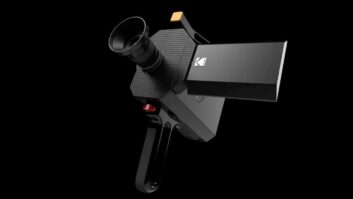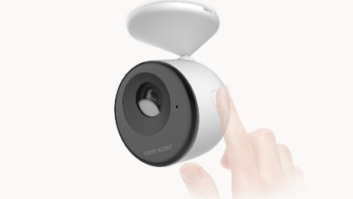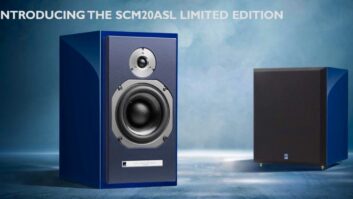ORLANDO, FLA. -Hybrid digital camcorders/still cams were on parade at the PMA trade show, here, as Canon, JVC, Panasonic and Sony all presented new models.
Canon announced three new digital camcorders in its ZR series: the ZR20 MC (March, suggested retail price $799), ZR25 MC (April, $899) and ZR30 MC (May, $999).
All of the new camcorders feature a 10x optical zoom lens and 200x digital zoom lens for wide panorama to telephoto images; image stabilization, flexible LCD viewscreen and color view-finder, programmed auto-exposure, and choice of digital effects, such as fade trigger, vertical wipe, horizontal wipe and mosaic fades.
The camcorders also feature multiple shooting modes. The video mode captures full-motion video for playback on a miniDV cassette, while the digital still mode captures still images on MultiMedia cards or SD cards (for the ZR25 and ZR30).
The ZR25 and ZR30 come with an 8MB MultiMediaCard and feature a progressive photo mode that simulates progressive-scan recording on an interlace CCD image sensor.
Exclusive to the ZR30 is an extended recording function that increases the length of recording time per cassette. To achieve this extended recording time, 2x greater image data compression is applied in the ESP mode and 3x in the ELP mode. In ELP, an 80-minute miniDV tape will record four hours of video footage.
JVC, with the help of astronaut Dr. Story Musgrave, unveiled the GR-DVP3 miniDV camera-dubbed the “microPocket DV” (available in May at a $1,699 suggested retail).
With its 680,000-pixel CCD and its Super High-Band Processor, the GR-DVP3 comes with a full set of multimedia interfaces and features-including JVC’s exclusive MPEG-4 video clips for e-mail, MP3 sound effects, a USB connector and an SD memory card slot.
In combination with a new Super High-Band Processor, a 680,000-pixel CCD image sensor produces 520 lines of horizontal resolution. The GR-DVP3’s built-in digital still camera can capture still images for output in either XGA mode (1,024 x 768 pixels) or VGA mode (640 x 480 pixels).
The HG Snapshot function is able to deliver high-resolution still pictures using the combination of a mechanical shutter system and the 680,000-pixel CCD. By emulating the operation of a progressive-scan CCD, HG Snapshot enables moving subjects to be captured for non-jittery stills.
The GR-DVP3 is provided with a variety of multimedia interfacing capabilities, such as a DV input/output (i.Link, IEEE 1394 compliant) terminal, a USB terminal, and a removable SD Memory Card (8MB) compatible with conventional MultiMediaCard.
The camcorder also features a 10x optical zoom and 200x digital zoom. To improve image resolution at high zoom ratios, the digital zoom uses spline interpolation to smooth contours and minimize jagged edges.
JVC’s Digital Image Stabilizer recognizes the user’s unique camera-shake characteristics to eliminate shaky pictures more effectively, the company said.
JVC is also offering a new pro-grade digital camcorder, model GR-DV2000, featuring a single 680,000-pixel progressive-scan CCD and high-resolution optics with an SLR-style focusing ring. The 1.92-megapixel pixel-shift technology will deliver 1,600 x 1,200 (UXGA level) still pictures. Stills are stored on an SD Memory Card or MultiMedia-Card (a 16MB MMC is provided). It ships in March at a $2,199.95 suggested retail price.
Sony Electronics introduced two miniDV Digital Handycam camcorders, the DCR-TRV17 and the DCR-TRV30. The latter is touted by the company as being the industry’s first 1.5-megapixel CCD camcorder with an intelligent pop-up flash and precision color viewfinder.
The DCR-TRV30’s 1.5-megapixel imager delivers up to 530 lines of horizontal resolution and 1,360 x 1,020 digital still images. To enhance the imager, Sony has incorporated an intelligent pop-up flash to help capture still images in difficult lighting situations.
In Digital Still Memory Mode, the intelligent pop-up flash system communicates with the camera for the optimum exposure.
The intelligent flash has four modes: automatic, automatic with red-eye reduction, forced flash or no flash. The camcorder has a color viewfinder and a 3.5-inch SwivelScreen LCD monitor.
The DCR-TRV17 and the DCR-TRV30 are replacement models for the DCR-TRV11 and the DCR-TRV20, respectively.
Both models offer three ways to record MPEG video. First, an MPEG conversion feature allows consumers to select up to 60 seconds of recorded videotape and convert it to an MPEG movie. Second, consumers can shoot an MPEG movie “on location.”
Finally, through the DCR-TRV17 and the DCR-TRV30 Audio/Video inputs, video can be imported from an external source-such as a VHS deck, Video Walkman VCR or analog camcorder-and converted to an MPEG movie and saved to the supplied Memory Stick media.
In addition to the above feature set, the DCR-TRV17 and the DCR-TRV30 are equipped with Carl Zeiss lenses; a mechanical shutter system that provides progressive-scan performance; 10x optical/120x digital zoom that uses interpolation technology, so digital zooming is cleaner with less distortion than conventional digital zooms, Sony said.
The DCR-TRV17 and the DCR-TRV30 will be available in April for about $1,100 and $1,700, respectively.
Panasonic Consumer Electronics Company displayed three new Palmcorder combination digital camcorder/digital still cameras, which will begin shipping in May.
Models PV-DV851 ($1,599.95) and PV-DV901 ($1,799.95) pack a megapixel CCD capable of producing up to 500 lines of horizontal resolution or 1,200 x 900-pixel still image resolution.
The top-of-the-line model, the PV-DV951 ($2299.95), is equipped with the same type of 3CCD camera system used in Panasonic professional broadcasting equipment.
The progressive-scan mode creates images with double the resolution of interlaced video, with virtually no motion artifacts.
The PV-DV951 Digital Palmcorder is capable of up to 540 lines of horizontal resolution and 1,488 x 1,128-pixel still images.
The PV-DV951 borrows optical technology from Leica (the Leica Dicomar lens) and also features a new optical image stabilizer system.
All three models can take SD memory and have i.Link interfaces.













